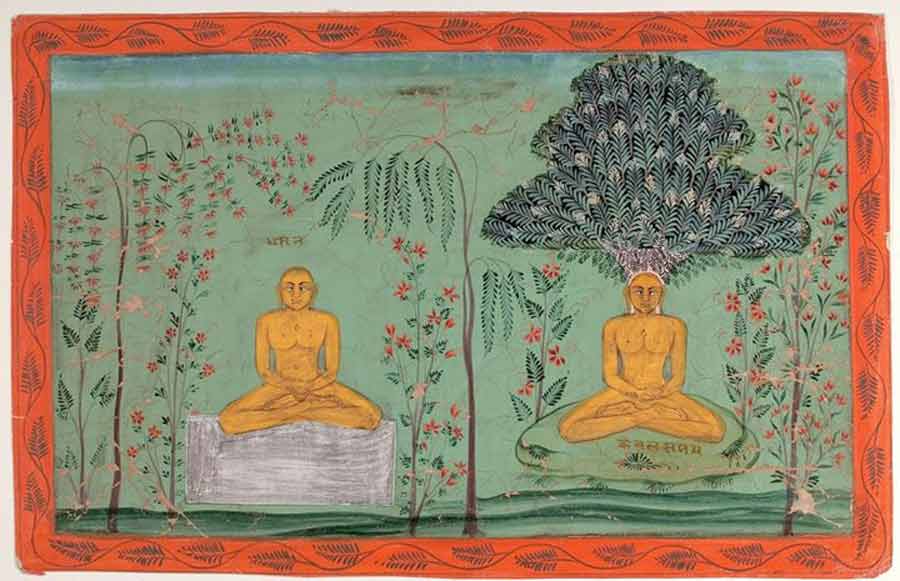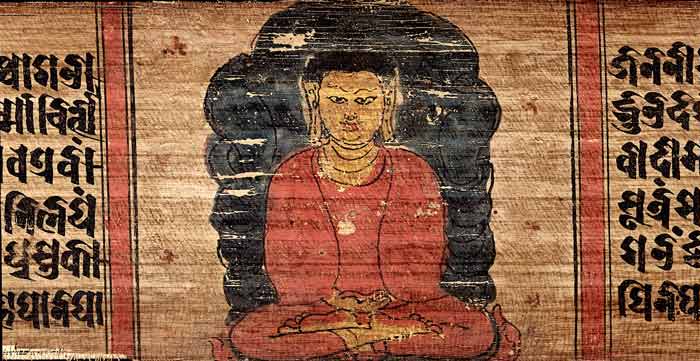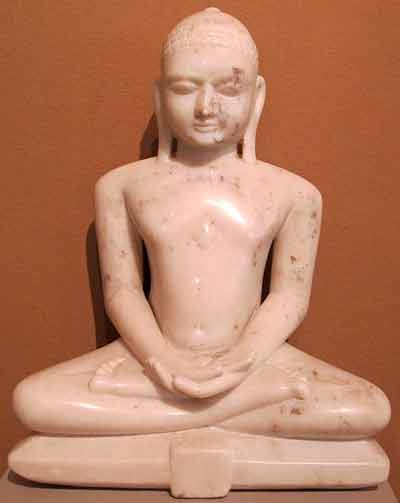
Rishabhanatha sitting in two stages of meditation, cca. 1680. San Diego Museum of Art
Editor's Note: Dr. Miller has translated several classical Indian texts from Sanskrit into English. This is the sixth part of Richard's translation of Patanjali's Yoga Sutras, along with his rich insights and incisive commentary.
Read Previous Chapters:
I. 30-32
Obstacles to Awakening
Enlightenment is supported by our ability to maintain sustained intention and attention for recognizing our underlying and unchanging Essential Nature.
The tendency of the mind to get involved with, and distracted by changing phenomena (vikṣepaḥ) needs to shift so that we are able to sustain
self-inquiry (antarāyaḥ), no matter what else may be arising in the body, mind, or world. Understanding this, Patañjali suggests a variety of obstacles that we need to be aware of, which can interfere with our ability to maintain
focused intention, curiosity, and sustained self-inquiry.
What are obstacles that interfere or distract the mind with regards to awakening to Essential Nature?
I. 30. vyādhi - styāna - saṁśaya - pramāda - ālasya -
avirati - bhrāntidarśana - alabdhabhūmikatva -
anavasthitatvāni - cittavikṣepāḥ - te - antarāyaḥ
vyādhi: dis-ease
styāna: dullness
saṁśaya: doubt
pramāda: carelessness
ālasya: laziness
avirati: clinging to sensory pleasures
bhrānti: incorrect perception
darśana: seeing
alabdha: failure to attain
bhūmikatva: ground
anavasthitatvāni: failure to maintain
citta: mind
vikṣepaḥ: distractions
te: these
antarāyaḥ: obstacles
Obstacles
that distract and interfere with maintaining focused attention in the pursuit of the realization of our Essential Nature include: 1)Dis-ease, 2) mental dullness, 3) doubt, 4) carelessness, 5) laziness, 6) clinging to sensory pleasures, and the 7) inability to correctly perceive, 8) attain, and/or 9) maintain a firm and solid ground of meditative self-inquiry.
The obstacles singled out by Patañjali, in and of themselves, are not the
problem. The real issue is our mind’s tendency to identify with, and become distracted by, these, and other changing states of body and mind.
When the mind is properly oriented, and there has been a glimpse of unchanging Essential Nature, we are capable of distinguishing between what is changing
and what is unchanging. With this orientation in place, it is helpful, through the various practices offered by Patañjali in his eightfold path of Yoga, to
purify the body and mind of the tendency to become distracted by these obstacles.
1. Dis-ease, whether physical (vyādhi: vyā) or mental (adhi) causes the mind to be drawn into distress, un-ease, anxiety and fear.
2. Dullness or sleepiness (styāna) can easily distract and defocus attention from self-inquiry.
3. Doubt (saṁśaya) undermines attention. Unshakable faith is needed to sustain focused self-inquiry. Doubts are inevitable as one treads the path of
awakening. The mind needs to remain unattached to them lest they increase their hold and highjack attention.
4. Carelessness and procrastination (pramāda) are overcome when we have in place a strong intention towards awakening.
5. Lethargy (ālasya) is a mental state that is inevitable. By recognizing it as a changing state, it can serve as a pointer to unchanging Essential Nature
within which it arises.
6. Clinging to objects of pleasure (avirati) distracts the mind from recognizing the ever-presence of Essential Nature.
7. Mis-perception (bhrāntidarśana), the taking of things for what they are not, is due to a lack of the mind’s ability to discriminate (vairāgya)
unchanging Essential Nature from the myriad of changing phenomena that are constantly arising in the mind and body.
8. Failure to attain a state of sustained focused attention (alabdhabhūmikatva) is counteracted by the development of inexhaustible patience, perseverance,
persistence, love, curiosity, and the capacity for surrender to ever-present Essential Nature.
9. Inability to maintain that which has been attained (anavasthitatvāni) is counteracted through sustained abiding as Essential Nature.
Other obstacles include personality and character defects, which are dealt with through the application of inner and outer vows (yāmas and niyāmas); past
unresolved actions, whether in thought or action (karma), which are dealt with through positive actions taken within one’s life in the world (karma yoga);
and mental or emotional attachments, which are dealt with through devotion and surrender (īsvara prānidhānāni).

Buddha in Dhyana, Wellcome Collection
How do we know when we are being disturbed by the presence of a hindrance or obstacle?
I. 31. duḥkha - daurmanasya - aṅgamejayatva -
śvāsapraśvāsāḥ - vikṣepasahabhuvaḥ
duḥkha: consumed with the pain of sorrow
daurmanasya: anxiety
aṅgamejayatva: unsteadiness
śvāsapraśvāsaḥ: irregular breathing
vikṣepa: distraction
sahabhuvaḥ: accompany
The presence of various symptoms in our body reveals the extent to which the mind is disturbed by particular obstacles. Such effects can include mental
agitation such as 1) anxiety and 2) depression; (3) physical restlessness or agitation, and (4) irregular breathing. By
inquiring into these symptoms it is possible to understand the degree to which the mind is disturbed by the presence of a particular hindrance.
Patañjali’s yoga sutras address a variety of physical and mental obstacles or hindrances that can potentially distract us as we engage meditative
self-inquiry into realizing our Essential Nature. He also suggests a variety of symptoms that can co-arise when we begin to be distracted by a particular
hindrance. What should be kept in mind is that the presence of these symptoms is not a problem, as such, as they act as messengers to alert us to the fact
that we are separating. Once alerted, we can then inquire into their origin and cause (kleśa), and remedial actions we need to take with respect to them.
So we should be grateful for the presence of any symptom arising in our body or mind, for they are all allies in our path to enlightenment.
Obstacles, and any resulting sorrow and suffering (duḥkha tāpa) that arises with respect to their presence, are inevitable facts of life, and can be assigned to
three three categories (tāpatraya: 3 types of misery: ādhyātmika, ādhidaivika and ādhibhautika).
1. Subjective: suffering that arises within ourselves (ādhyātmika), which is caused by mental dis-eases such as anxiety, fear, anger, hatred, greed or
physical dis-eases such as illness, discomfort or pain.
2. Objective: suffering that is inflicted by another living creature (ādhibhautika) such as by thieves, snakes, car accidents, acts of war, etc.
3. External: suffering that is the result of unseen forces or natural calamities (ādhidaivika) such as acts of nature, i.e., floods, fires, earthquakes,
etc., which are beyond human control.
Some obstacles, like hereditary and physical diseases and disabilities must be endured. Others that are caused by psychological states or change of seasons
can be dealt with by taking appropriate measures or precautions. That said, the ultimate way of dealing with any limitation imposed by the body or mind is
to realize Essential Nature, which allows you to know what it is about yourself that is always whole, healthy and perfect, no matter the state of the body
or mind.

Tirthankar sitting, cca. 18th century
What are the measures we can take to overcome the hindrances?
I. 32. tatpratiṣedhārtham - ekatattvābhyāsaḥ
tat: that
pratiṣedhārtham: removing
eka: single
tatvā: principle
ābhyāsaḥ: practice
Whereas there are many methods that can help overcome distractions, frequent change of one method for another can become a source of distraction.
Therefore, in order to overcome mental distractions, you should adhere steadily, over time, to the practice of one method.
In this sutra, Patañjali affirms that the best way to reverse the mind’s tendency to be distracted is by developing the capacity to firmly engage in the
practice of one method. Then, obstacles naturally subside over time as purposeful practice is sustained.
Sustained practice grows our capacity to embody energy, devotion, patience, persistence, and perseverance with standing firm in the understanding that the
objective of yoga—enlightenment—already lies within, and not in some outer, or even inner achievement.